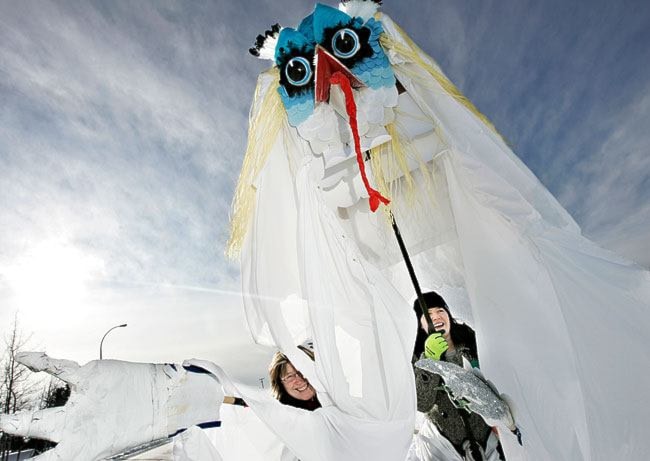‘Fire purges, fire has always purged,” said Arlin McFarlane, organizer of Burning Away the Winter Blues.
Taking bad things and making them burn would be an apt description of McFarlane’s 10-year-old Spring Equinox festival
Every year, on the first day of spring, a torch-carrying crowd winds its way to a massive bonfire within Robert Service campground. There, revellers are encouraged to gather up their end-of-winter grievances and cast them into the roaring flames.
When the practice began, McFarlane quickly had to put the kibosh on bonfire disposals of faulty electronics.
“That’s when I started to say, ‘paper representations,’” she said.
“Back-stabbing people,”“feelings of apathy” and “financial worry” found their way onto scraps of paper and cardboard, where they were absolved by the cleansing inferno.
The lighthearted practice of burning your blues soon struck a serious, almost cult-like chord with revellers.
“All through time we’ve sought symbolic ways to relieve our burdens,” said McFarlane.
Medical results and divorce papers are popular bonfire fodder.
McFarlane has seen pieces of paper filled “front to back” with family woes.
Medical records and divorce papers have joined the embers of disappointment.
Two people have even cast their last pack of cigarettes into the fire, vowing never to smoke again, said McFarlane.
“Burning away the old and making way for the new—I think that’s somehow deeply rooted inside of us and we all respond to it,” said McFarlane.
In ancient Hebrew tradition, villagers would dump all their yearly gripes onto a random goat. Then, the goat who be cast off into the wilderness to die.
Setting grievances on fire is an even more ancient practice, and also removes the need for a hoofed middleman.
Burning Away the Winter Blues’ spectacle of misfortune-on-fire has its crowning touch when winter himself joins the roaring flames.
Every year, a different Whitehorse artist is commissioned to build a grotesque puppet in the guise of winter. Revellers are dutiful followers of the hideous mannikin as it leads them to the bonfire. Once the destination is reached, however, the torch-bearing crowd quickly turn on their gnarled master.
With cheers, the puppet is heaved into the flames, where it is quickly engulfed.
The burning of effigies has a long and storied history.
Following the failed attempt by Catholic conspirators led by Guy Fawkes to blow up Britain’s Parliament, the country began an annual tradition of burning an effigy of Fawkes to celebrate “the deliverance of the king.”
Protestants in New England adapted Guy Fawkes day into an anti-Catholic festival with effigy burnings of the pope.
In another part of New England, the residents of Salem, Massachusetts, dispatched with effigies altogether, electing to burn accused witches in their stead.
In modern times, students at Lake Superior State University in Sault Ste. Marie will renew a 40-year-long tradition this equinox by welcoming the spring with the burning of a four-metre tall paper snowman—done up this year as a banking and investment mogul.
Whitehorse’s festival came to being on much more innocent pretense.
When McFarlane first arrived in the territory, she had bandied about the idea of bringing a lantern festival to Whitehorse.
In cities such as Vancouver and Victoria, lantern festivals have become cherished community institutions. Overnight, public parks are transformed into whimsical playgrounds of paper lanterns.
But a festival of flimsy paper and wax creations clearly wouldn’t cut it in the Canadian North.
Lanterns are weak. They melt in the rain; they are vulnerable slight gusts of wind and they crack in the cold.
A bonfire seemed the stouter option.
Admittedly, the idea was nothing new in the bush-party-saturated Yukon. That’s why McFarlane added a twist: revellers would be given torches, and would journey to the bonfire in drumming procession—like murderous villagers on their way to Frankenstein castle.
With revellers spurred on by a common destination, a fellowship is spurned, said McFarlane. Assailed by icy waterfront winds, the crowd’s hatred of winter is reinforced.
“You earn the warmth of the bonfire,” said McFarlane.
The spectre of winter, this year, has been created by mixed-media artist Emma Barr.
Barr’s effigy is the first to be non-humanoid. Past festivals have generally depicted a haggard, old man figure, physically twisted and crooked by the ravages of the season.
Hated, yet pitiful.
Barr has cast winter as a snarling falcon-type creature—a mythological Egyptian take on the hated season.
Playfully peppered with pagan symbology, Burning Away the Burning Blues has resonated strongly with the locals who constitute the festival’s ever-growing slate of participants.
Fireside rituals hearken back to an endemic theatrical instinct—predating even verbal communication, said McFarlane.
“People would dance around the fire the night before a hunt, and they would repeat things in specific ways because that would hopefully guarantee them a good hunt,” she said.
Dancing led to chanting, which led to singing, which led to lyrics.
Eventually, humankind ended up with Shakespeare.
Fire rituals speak to something with us all, said McFarlane.
And compared with typical Yukon Arts Centre production, fire rituals also cost far less.
Contact Tristin Hopper at
tristinh@yukon-news.com
